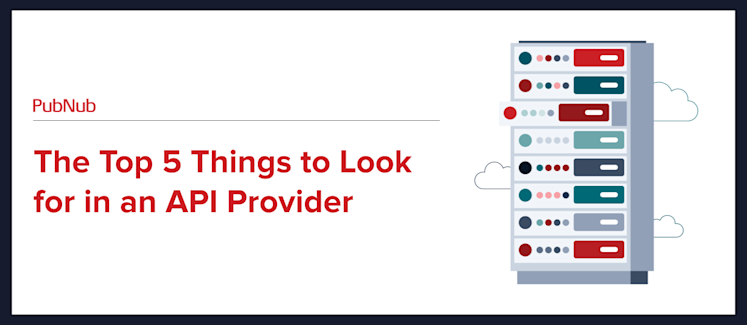
According to Vantage Market Research, the global application programming interface (API) management market size was valued at $4.2 billion in 2021. It's expected to grow at a compound annual growth rate (CAGR) of 24.8% through 2028, reaching over $15.86 billion. This rapid growth shows that the use of APIs and API providers is on the rise, and this trend is expected to continue in the coming years as more businesses look to leverage digital technologies to drive growth and innovation.
However, before contracting API providers to overhaul their workflow processes, developers need to be aware of some emerging trends and best practices that will accelerate throughout this decade. So if you are considering working with an API partner, keep the following five factors in mind.
1. Scalability and integration
Businesses want APIs that can handle increased traffic and usage as their needs grow. Therefore, API providers should ensure that their APIs are scalable, flexible, and can accommodate the needs of growing businesses. Moreover, the APIs must be reliable and consistent in delivering data and services. This means minimizing downtime and ensuring that data is secure and accessible at all times.
Along with scalability, the ability to integrate with other systems and applications is essential for businesses. providers need to ensure their APIs can integrate seamlessly with existing workflows and software, making it easy for businesses to adopt the API without significant disruptions.
2. Security
Security is a top priority for organizations, and API providers must ensure that their APIs are secure and comply with industry standards and best practices. One way to reinforce security is by offering alternative API architectures that can provide additional layers of protection.
For example, some API providers may offer a microservices-based architecture that breaks down the API into smaller, more manageable components. This can help reduce the attack surface(and vulnerabilities) and make it easier to secure individual components.
Another approach is to offer a serverless architecture, where the API provider manages the infrastructure and handles security, scaling, and availability on behalf of the organization. This can help reduce the burden on the organization’s IT team and ensure that security is always maintained.
Overall, API providers need to be aware of the evolving security ecosystem and provide alternative API architectures that can help reinforce security standards and ensure that their APIs are secure and trustworthy.
3. Customizability
Customization is a crucial factor when it comes to app development and adoption. Many businesses have unique needs and requirements for their workflows. API providers should be able to provide customization options that can adapt to specific business needs and enable companies to tailor the solution to their specific use cases.
API customization can take many forms, including custom endpoints, data models, authentication and authorization mechanisms, error handling, and more.
4. Ease of testing
Ease of testing is an important consideration for developers when developing and deploying their apps. To ensure that their apps are reliable and perform as expected, API providers should provide testing and debugging tools that can make it easier for developers to test and validate their APIs, reduce the risk of errors and downtime, and ultimately provide a better user experience for their customers.
Some other key factors that can contribute to the ease of testing include:
Internal reporting protocols: Solution providers should have internal reporting capabilities that enable developers to monitor and troubleshoot their apps in real time. This can include detailed logging, error tracking, and performance metrics that can help developers identify issues and optimize their apps for better performance.
API Documentation and sample code: There should be clear documentation and sample code that makes it easy for developers to get started with the platform. This can include code snippets, tutorials, a developer portal, and other resources that help developers understand how to use the tool effectively.
5. Artificial intelligence/machine learning (AI/ML)-enabled automation
Organizations today are looking for AI/ML-enabled APIs that can help them automate parts of their workflow, reduce errors, increase efficiency, and ultimately drive business growth and success. By leveraging machine learning and artificial intelligence, these APIs can help companies analyze large amounts of information, identify patterns, and automate routine tasks.
Some examples of AI/ML-enabled APIs are:
Natural language processing (NLP) APIs: These can help companies extract insights from unstructured data, like user feedback, social media posts, and support tickets. By analyzing the text and identifying key phrases and sentiments, NLP APIs can help automate tasks such as categorizing support tickets, identifying common issues, and routing tickets to the appropriate team members.
Image and video recognition APIs: These can help businesses automate tasks such as content moderation, product identification, and quality control. By analyzing images and videos, these APIs can identify objects, faces, and other features, making it possible to automate tasks such as identifying counterfeit products, detecting defects in manufacturing, and flagging inappropriate content.
Predictive analytics APIs: These APIs can help businesses analyze data to predict future outcomes. For example, businesses can use predictive analytics to forecast product demand, optimize pricing strategies, and identify growth opportunities.
Choose the right partner
Looking to build apps that require real-time interactivity APIs? Consider working with a security-conscious solution like PubNub that understands the significance of maintaining strict security standards when developing apps.
With 15+ global points of presence that support over 800 million monthly active users, PubNub’s real-time communication platform offers 99.999% reliability, ensuring you never have to worry about concurrency limitations, outages, or any latency problems instigated by traffic spikes. We empower developers to develop, deliver, and manage real-time interactivity for mobile apps, web applications, and Internet of Things (IoT) devices.
Sign up for a free trial or contact our sales team to discuss your project.

